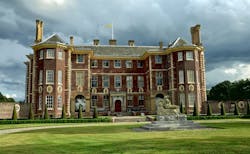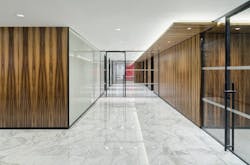Technology leads the way in today’s coatings and sealants [AIA course]
Does history hold the key to the next coating or sealant specification? Yes, as a brief review of technologies old and new reveals the science behind their benefits for building construction and operations.
Historically, mud huts could be built anywhere, and in any shape to please the builder. But the finish depended on whatever the earth and clays offered. Enter lime plaster, the ancient technique for creating a hard, solid, and durable mass finish that resists water for decades. Ideal for exterior plastering, lime plaster is less brittle and cracks much less than cement plaster. Typically, it requires no expansion joints. Recent science reveals the surfaces even have a natural fungicidal quality, thanks to their elevated pH levels.
Composed of sand, water, and slaked (high-calcium) lime, ancient lime plasters could be applied with horse hair for reinforcement as well as pozzolan additives, such as fly ash, silica fume, or rice hull ash, which reduces the material’s working time. One of the oldest enhancements of lime plaster is seen in Japanese shikkui, a mix of hydrated lime and calcium carbonate from reprocessed eggshells.
LEARNING OBJECTIVES
After reading this article, you should be able to:
+ EXPLAIN the primary sustainability considerations for coatings and paints, including life cycle performance and toxic content.
+ DISCUSS sustainability and air quality considerations related to coatings, including historically prominent coatings and currently used products.
+ LIST the beneficial attributes of long-standing coating and sealant technologies, including lime plasters and mortars.
+ DESCRIBE how durability and resource conservation are related to the selection and application of coatings.
EDITOR’S NOTE
This completes the reading for this course. To earn 1.0 AIA CES HSW learning units, study the article carefully and take the exam posted at: www.BDCnetwork.com/CoatingsSealants
Used primarily for interiors, the highly elastic, two-coat product resists stress cracks. It is often customized with color pigments, stone effects, and a Venetian stucco appearance. Yet it is highly porous and naturally antiseptic, according to the latest scientific research, actively enhancing indoor environmental quality by absorbing carbon dioxide and filtering and refreshing the air. It regulates humidity, inhibits fungus and mold, resists fire, and prevents dust accumulation.
Building Teams should consider using shikkui, says Stewart Ratzker, President, Advance Coatings Group. Shikkui comes from a rapidly renewable source, requires little energy for production, and is fully recyclable or decomposable. It also tends to capture VOCs and odors, says Ratzker. Shikkui products have been tested against a number of basic ASTM International standards for hardness, mold resistance, VOC content, and fire resistance.
The history of paints and decorative coatings has not been quite so environmentally benign, though the products have served a variety of needs admirably. The materials complemented such basic advances as cladding with wood, masonry, and metal, materials that were essential to creating durable, attractive, healthy dwellings. The notion that the panels could be treated with paint to improve their looks and longevity was an equally astounding development, emerging on the scene 300 to 350 years ago. The 17th-century Ham House, in Surrey, England, is one of the oldest surviving examples of a structure treated with oil paints. Studies revealed a primer was used along with numerous undercoats and a highly decorative finish coat. The original paint mixtures used a white lead powder, oil, and other pigments.
Three basic components comprise the modern notion of paint: a binder, resin or film-former (such as oils, acrylics, alkyds, polyurethanes, or epoxy); a solvent or diluent—sometimes called the vehicle—to help control flow and application properties and then evaporate; and the body of pigments and fillers to add color, texture, and toughness. A fourth component is the full range of additives, such as thickeners, flatteners, UV stabilizers, catalysts, and even biocides, that can be added to paints today.
Another historical success story comparable to paint can be found in the highly resilient, very tough surface finishes such as lacquers. These fast-drying, hard, high-gloss surface coatings are applied as varnishes made from dissolved cellulose derivatives and other modifying materials in a solvent, with an option to add a pigment. This technique has been in use in China for thousands of years by using the sap of a sumac tree, Rhus verniciflua, to finish wood, bamboo, and metal objects, according to crafts expert Jacky Chen. “The resulting surface is hard and impermeable and can be polished, colored, or delicately carved to reveal the successive layers beneath,” according to Chen.
We’re seeing a resurgence in the use of lacquered finishes for interior surfaces, casework, and other specialties, says Wendi Stallings, Principal of hospitality design firm Private Label International (privatelabelintl.com). “They lend a luxurious finish to modern interiors while hinting at a retro glamour,” she says. Lacquer is frequently paired with materials such as metal and wood to create visual and textural contrasts, she adds.
Lacquered surfaces ranging from matte and rubberized to liquid gloss offer a wide range of possibilities, including time-honored ornamental lacquer techniques and effects, says Stallings. Examples include the pairing of matte black lacquers with shiny copper, or glossy white lacquer matched with burnt gold.
Recent scientific advances in lacquer formulations make the finishes stable, less toxic, and more resilient. New waterborne pre-catalyzed lacquers are low in volatile organic compounds (VOCs), free of hazardous air pollutants (HAPs), and contain no formaldehyde or isocyanate. For at least a decade, water-based lacquers have been available that fall far below EPA’s VOC limit of 350 grams per liter for lacquer.
MODERN AND GREENER COATINGS
The modern history of paints, sealants, and coatings begins about the time of World War II, when a number of materials were introduced as substitutes for items in short supply: for example, artificial resins known as alkyds were a good match for linseed oil, which could not be harvested quickly enough to meet wartime demand.
Rubber substitutes, such as polyurethanes, were found valuable for use in paints, sealants, rigid insulation, soft foams, and elastic fibers. The German industrial chemist Otto Bayer invented the basic di-isocyanate polyaddition process to create the organic polymer, according to the American Chemistry Council. High-gloss and highly resilient finishes for aircraft metals, wood structures, and masonry assemblies were among the first applications of polyurethanes. Not long after, fluoropolymers, such as PVF (polyvinylfluoride) and PVDF (polyvinylidene fluoride), were brought into commercial use, offering strong and lasting finishes with very high melting points.
More recent advances include nanotechnologies and reactive formulations that confer astounding advantages. Intumescent paints, including thin-film coatings for structural steel fire protection, have emerged in recent decades, according to the U.K.-based Steel Construction Institute (www.steel-sci.org). Nano-enhanced coatings provide such properties as hydrophilic action, which attracts water and can make some surfaces self-cleaning. Other formulations can create thin insulating layers, such as the new metal coatings combined with aerogels that inhibit condensation.
As these example show, coatings and sealants can offer a range of benefits: improved IEQ, greater end-of-life options, and reductions in greenhouse gas emissions. Some coating components provide an artificial replacement for scarce natural resources—alkyds in place of linseed oils. Others use renewable and perpetual resources, such as limes and clays. Some coatings provide alternatives to toxic materials like lead or high-VOC substances. Other historic coating processes are known to yield durable, attractive surfaces. Some even obviate the need for sealants, expansion joints, and gaskets.
COATING FOR SUSTAINABILITY
Product decisions and specifications that offer the most benefit from paints and coatings should be guided by a firm understanding of the most critical performance criteria: life cycle performance, toxicity, durability, and the conservation of resources. Alternatives to paints and coatings should also be considered in the right circumstances.
1) Life cycle performance. This category includes such factors as the type of substrate and its condition; for example, metal substrates can be affected by corrosion, temperature changes, and moisture migration.
Take the case of oil-based and water-based (latex) products. Oil binders provide effective application to most materials, except for galvanized metal, with which they are generally not compatible. For stucco, cast concrete, and most masonry, a pretreatment or sealer must precede the oil-based coating, according to manufacturer Glidden Professional. Latex coatings suit such substrates as wood, brick, concrete, stucco, brick, aluminum, vinyl, and galvanized steel. In most cases, they offer excellent adhesion and better elasticity than oil-based formulations. For heavily chalked substrates and other situations where better adhesion is required, oil products may be more suitable.
Color retention is another factor to consider. In sunny locations, where vibrant, original colors should be maintained, water-based products provide better UV resistance than their oil-based counterparts, which can chalk and fade more quickly. For mold and mildew resistance, some oil resins provide nutrients for microbiological growth; this problem is usually treated with biocides in the formulations of both latex and oil coatings. Oil products also tend to have a more powerful odor than latex formulations. They also require solvents such as turpentine for cleanup—a consideration for renovation projects near occupied areas.
2) Toxicity. Odors can be a sign of unhealthy off-gassing. Some commonly used coatings emit vapors that may persist for months after construction is completed. These include VOCs and hazardous air pollutants. It is important to note that the content of coatings alone does not fully characterize the product’s contribution of HAPs and VOCs, says Andy Pace, of Safe Building Solutions (www.thegreendesigncenter.com). He cites research by EPA’s National Risk Management Research Laboratory (http://1.usa.gov/1SOcgxi), which states that “emission behaviors” depend on whether the chemicals are applied to “non-absorptive substrates” such as glass, aluminum, and stainless steel, as opposed to “absorptive surfaces,” such as wood and gypsum board.
Recent research into HAPs and VOCs shows that, for a substrate such as gypsum board, it can take up to three-and-a-half years for certain VOCs to be released. With coatings such as latex paints, most of the emissions occur after the coating has dried. For these reasons, VOC emissions could be a more useful measure for you to consider, rather than VOC content.
In terms of emissions, labeling products “low-VOC” and “zero-VOC” tends to oversimplify the picture of which products are really safest. For example, according to Pace, “Some paints marketed as ‘low-VOC’ may still emit significant quantities of HAPs.” He notes that some alkyd coatings contain as many as 100 different VOCs.
Large-volume users, such as Washington State’s Department of Ecology, recommend using green certifications and standards to guide specifications and purchasing decisions. These include multiple-attribute, third-party certifications and standards that address toxicity, emissions, and performance, such as Green Seal, UL’s EcoLogo, and the Master Painters Institute Extreme Green. There are also “single-attribute certifications and standards,” such as USDA Certified Biobased and the commonly used VOC and HAP criteria from the South Coast Air Quality Management District.
According to Green Seal’s standard GS-11 for architectural coatings, stains, finishes, and sealers, specific harmful materials are prohibited. These include HAPs, heavy metals, phthalates, triclosan, so-called “formaldehyde donors,” carcinogens, and ozone-depleting compounds. Several known toxins—notably titanium dioxide, carbon black, crystalline silica, and PCBTF—are noteworthy exceptions, because they are needed for coating performance. Yet according to the American Coatings Association, toxic air releases from coatings decreased by about 80% between 1995 and 2011. Today, more than 90% of U.S. architectural coatings sales are for environmentally preferable water-based paint.
ANCIENT ADVANCES, SCIENTIFIC SECRETS
Plasters have been in use since at least 7500 BC in Jordan, and lime plaster can be found in the walls of early Egyptian tombs. Builders in the Roman Empire used mottled stucco in many structures, although it wasn’t until the Renaissance that marble dust was first added to plaster, allowing for the hard, smooth finish forever associated with Venetian palazzos.
As with coatings, traditional sealants are making a comeback. For centuries, lime-based mortars were the sealant of choice. Hydraulic lime mortars, which are set through a hydration reaction, have been used in a wide range of applications, including the Pantheon in Rome. In the 19th century, ordinary Portland cement (OPC) gained favor for its quick setting speed, ease of use, and high compressive strength, and hydraulic lime mortars took a backseat in the building trades.
Recently, this older sealant technology has experienced a resurgence in popularity among contractors who recognize that lime mortar’s elasticity allows for expansion and contraction of the building walls without damaging masonry units. Lime mortar also offers high levels of water resistance and superior bond strength, especially when used in concert with lime-based plaster coatings.
Not until 3000 BC, when Egyptian artisans and builders created synthetic pigments in a variety of colors, did the manufacture and use of paint reach a state that we would recognize today. The period 600 BC to 400 AD saw the Egyptians, Chinese, Hebrews, Greeks, and Romans begin to use oils as varnish. It took until the 16th century for artists to begin adding drying oils to paints. In this era, too, linseed oil took hold as one of the first widely used solvents, a role it held until it was replaced by synthetics in the 20th century.
Early synthetic dyes, water-based paints, and ready-mixed paints entered mainstream use in the late 1800s. These advances continued into the 20th century, when synthetic polymer vehicles like polyurethane and styrene-butadene and the advent of aerosol technology fundamentally changed the nature and application of many paints.
3) Durability. Building materials should hold up to the rigors of building operations, traffic, and use to provide the best return on investment, ease of maintenance, and reduce the frequency of repairs. In terms of coating selection, the choice of binder is essential to the resilience of surfaces, according to IHS Engineering360 (www.ihs.com; see http://bit.ly/1lx7Ale). Acrylic binder coatings dry faster than alkyds and offer good environmental resistance, but alkyds are generally a better choice for wear resistance. Epoxy-based finishes do not shrink as much as other coatings. They are ideal for places where high strength is valued, such as floors, and where environmental and chemical harm is possible, such as industrial and laboratory settings. However, urethane binders may be preferred in some cases, thanks to their better impact resistance, flexibility, and overall high durability.
You may also try to minimize site-applied coatings while favoring factory-applied finishes, which afford greater quality control and can include resilient formulations such as powder coatings. Rather than relying on solvents for proper surface coverage, as with standard liquid paints, these thermoplastic or thermoset polymers are applied as solid particles electrostatically and then heated to create a uniform, fully coated surface—a process known as fusion bonding. In many cases, the shells left by liquid paints are not as environmentally resilient as powder coats comprising polyester resins and additives that make the colors and patterns sharp and vibrant. Powder coating is generally applied to metal materials, but it can also be used for fiberboard and other smooth substrates.
Powder coating and other processes, such as ink sublimation, can also be used to transfer decorative patterns to the substrates. This is a job best left to shop applicators, who have the industrial-sized sprayers, vacuums, and heating chambers needed to fuse the decorative coatings. Don’t try to do it yourself on the job site.
4) Resource conservation. As a component of life cycle performance, the reduction of raw or original materials needed for a given facility generally favors coatings that last longer between required reapplications. Recently introduced paint formulations use such materials as white clay, reclaimed marble, cellulose fibers, and other natural ingredients instead of petrochemicals.
The American Coatings Association reports that the paint and coatings industry “reduced its total production waste by 48% from 1995 to 2013, while increasing the percentage of the total waste it recycles by over 81% during that period.” In the field, unused paints should be recycled, along with empty metal and plastic paint cans.
In response to the EPA’s enforcement of the Resource Conservation and Recovery Act, leading paint manufacturers have significantly beefed up their environmental controls to close the loop on hazardous wastes. The EPA tracks five paint production residuals, including solvent cleaning waste, wastewater treatment sludge, water and caustic cleaning wastes, and dust emissions and sludge. Some manufacturers have gone above and beyond the regulations, opening LEED-certified paint production facilities with energy-efficient equipment, dust-collection systems to recycle particulates, and novel wastewater recycling techniques.
5) Alternatives to traditional coatings. Some architects, specifiers, and contractors are asking: If “living finishes” like shikkui have been proven safe, healthy, and durable, why paint gypsum board with low-performance latex paints, which may contain colorizing additives that could present some harm to some occupants? Why not use clay plaster, caseins, stone dust, and other materials known to be safe and effective?
These specifiers are choosing to work with unfinished surfaces, such as weathering steel or exposed concrete. Others are choosing historically proven finishes that may add a premium in first cost or project complexity: it may not be easy to hire a shikkui applicator in every corner of the U.S. Yet those costs may be offset by value in performance and well-being. The best example is natural clay plaster, a viable alternative to other indoor wall finishes applied to primed and sealed gypsum board, blueboard, wood sheathing, and other interior surfaces.
LEVERAGE THE HISTORY OF SCIENCE
Certain types of coatings, including plaster, have been in continuous use for centuries. Why have they stood the test of time? Generally speaking, these coating types have traditionally been easy to manufacture, require materials that are often readily at hand, and are produced via a fairly simple manufacturing process.
At a basic level, plaster is a paste formed from mixing a powder (traditionally gypsum, lime, or cement) with water. This reaction causes crystallization, hardening the plaster yet allowing it to be worked with tools to create the desired finish across a wide range of applications. In addition to forming basic coverings, plaster’s malleability means that it can be used to create highly complex detail work on walls or ceilings. This technique, known as plastering or rendering, is among the longest-standing features of traditional and neoclassical interiors.
Over the centuries, certain types of plaster have proven to be highly durable, and remain practical for modern use. Expect to see more use of shikkui, the ecological nontoxic Japanese lime plaster, which has been the finishing material of choice in Japan for over a thousand years. Recent projects like the modernist temple expansion (http://bit.ly/1SOssyB) by Zai Shirakawa Architects present a view of shikkui in action. Scientific studies confirm that slaked lime provides the added benefits of regulating humidity and a naturally high alkalinity that tends to control bacteria, viruses, mold, and fungi. The chemical behavior of slaked lime also draws carbon dioxide from the air, turning it into calcium carbonate, while on a physical level the surface is naturally antistatic, preventing dust accumulation.
Shikkui and other lime plasters also offer significant environmental benefits. Lime and shikkui plasters have contributed to LEED building credits, and some manufacturers are Cradle-to-Cradle certified. Cradle-to-Cradle certification is based on five performance categories: 1) using environmentally safe and healthy materials; 2) design for product reutilization; 3) use of renewable energy and energy efficiency; 4) efficient use of water in production; and 5) instituting strategies for social responsibility. A wide range of lime plasters (including many shikkui products) have earned this certification at the mid-range Silver level.
Other traditional plaster coatings include polished finishes such as Venetian plaster, which is made from lime-based plaster mixed with marble dust and provides robust hardness once dry. Venetian plaster allows for artisanal finishes that replicate the look of marble, travertine, or limestone. Yet it can be applied to surfaces and complex geometries where marble panels could not easily be installed, or in applications where real marble would be cost-prohibitive. Venetian and other polished plasters are highly resilient. Lime plasters perform well in wet climates because they allow any water that’s absorbed into the plaster to quickly evaporate. Unlike paints, Venetian plaster is self-healing and naturally mold resistant. Combined with its hardness, these properties ensure that Venetian plaster is a highly durable, environmentally friendly, coating.
Other forms of plaster are experiencing a resurgence, too. The Moroccan plastering technique known as tadelakt (roughly translated as “rubbed clay”) has re-emerged in the past decade among the new wave of traditional finishes. Like Venetian plaster, tadelakt is lime based, but it uses stone granules instead of marble. This particular plaster form is ideally suited for both exterior and interior applications because the stone polishing process that lends the coating its bright shine also creates a high level of water resistance and durability.
Despite these technological advances, traditional products continue to offer a range of benefits. Venetian plaster remains popular and still contains the mix of lime plaster and ground marble that has imbued it with desirable performance and aesthetic qualities for centuries. Lacquers also provide a lasting surface. They are produced by a curing or evaporation process in which a plant- or insect-based resin hardens into a durable coating, They also enhance daylighting and electrical lighting by providing a highly reflective interior surface. Lacquered surfaces are being used for ceilings in a variety of interiors, helping to bounce sunlight into these enclosed spaces.
Another major consideration is when and where to apply coatings and sealants. The key to specifying and applying any coating system or interior finish is to determine what will be applied in the shop or factory and what will be applied in the last stages of construction, which is more common for coatings and many sealants. Don’t focus solely on the base coating. Consider also any tints or additives that are used to modify or color the coatings, which may add VOCs or other hazardous content.
The construction team should be trained for field applications. Good ventilation is important during the applicators’ work. Doors and windows may have to be left open. Fans can be used to move fumes away from occupied areas or places where other crews are actively working. This can be especially important for solvent-based wood floor finishes and resilient concrete coatings. According to GreenBuilding, high concentrations of known carcinogens can be found in solvent-based adhesives, so they should either be eliminated from the specs or applied under strictly controlled conditions.
As historic and modern building technologies show, the variables of paint and coating selection not only impact environmental sustainability, they impact occupant health, safety, and welfare as well. In the use phase consider not only the effects of newly applied finishes—daylighting and reflective interior paints, and other productivity and psychological impacts—but also how long the typical surface needs to be used.
The science behind many historical finish systems shows that they evolved to be as durable, resilient and forgiving as possible. Whether lime plasters, hydraulic mortars, or lacquer coatings, using some of these technologies today may provide the best overall value for the building user group.
![Technology leads the way in today’s coatings and sealants [AIA course] Technology leads the way in today’s coatings and sealants [AIA course]](https://img.bdcnetwork.com/files/base/ebm/bdcnetwork/image/2024/09/66fb0ecd369555b7b2420a7c-screen20shot202016020520at2010.png?auto=format,compress&fit=fill&fill=blur&q=45&w=250&width=250)





